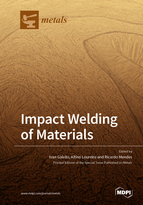Impact Welding of Materials
A special issue of Metals (ISSN 2075-4701). This special issue belongs to the section "Metal Casting, Forming and Heat Treatment".
Deadline for manuscript submissions: closed (1 July 2020) | Viewed by 46630
Special Issue Editors
2. CEMMPRE, Department of Mechanical Engineering, University of Coimbra, Rua Luís Reis Santos, 3030-788 Coimbra, Portugal
Interests: solid-state welding; friction stir welding; explosion welding; dissimilar materials welding; solid-state processing
Special Issues, Collections and Topics in MDPI journals
Interests: welding technology and metallurgy; joining of dissimilar materials; automation of joining processes; solid-state processing; mechanical behavior of welded joints; residual stresses
Special Issue Information
Dear Colleagues,
The recent industrial criteria, focused on obtaining increasingly efficient structures, require the production of multi-material components. However, the manufacturing requirements of these components are not met by conventional welding techniques. Alternative solid-state technologies, such as friction- or impact-based processes, must be considered. Impact welding processes have the advantage of presenting a very short-cycle time, which minimizes the interaction of the materials under high temperature. This strongly contributes to reducing the formation of brittle intermetallic layers, i.e. one of the main concerns in dissimilar welding. Moreover, as the influence of the welding process is confined to a very narrow band, similar and dissimilar welds with high-strength bonding and a minimal heat affected zone (HAZ) can be produced.
The impact welding family encompasses different welding processes, such as explosion welding (EXW), magnetic pulse welding (MPW), vaporizing foil actuator welding (VFAW), laser impact welding (LIW), etc. Although the main operating principle, consisting of a high velocity collision between a flyer and a target is shared by these processes, they differ in the way the flyer is accelerated. These processes also present very different length scales, providing the impact welding family with a broad applicability range. The technical and scientific interest in impact welding is driving the ongoing development of a large number of studies. The present Special Issue will present cutting edge experimental and theoretical research on all aspects of the multidisciplinary field of impact welding. Original research and review papers addressing new developments in similar and/or dissimilar joining by impact welding are valuable scientific contributions to this issue.
Topics of interest include (but are not limited to):
- Process developments;
- Industrial applications;
- Metallurgical characterization;
- Mechanical characterization and fracture analysis;
- Numerical modelling and simulation.
We look forward to receiving your contributions to this issue.
Prof. Dr. Ivan Galvão
Prof. Dr. Altino Loureiro
Prof. Dr. Ricardo Mendes
Guest Editors
Manuscript Submission Information
Manuscripts should be submitted online at www.mdpi.com by registering and logging in to this website. Once you are registered, click here to go to the submission form. Manuscripts can be submitted until the deadline. All submissions that pass pre-check are peer-reviewed. Accepted papers will be published continuously in the journal (as soon as accepted) and will be listed together on the special issue website. Research articles, review articles as well as short communications are invited. For planned papers, a title and short abstract (about 100 words) can be sent to the Editorial Office for announcement on this website.
Submitted manuscripts should not have been published previously, nor be under consideration for publication elsewhere (except conference proceedings papers). All manuscripts are thoroughly refereed through a single-blind peer-review process. A guide for authors and other relevant information for submission of manuscripts is available on the Instructions for Authors page. Metals is an international peer-reviewed open access monthly journal published by MDPI.
Please visit the Instructions for Authors page before submitting a manuscript. The Article Processing Charge (APC) for publication in this open access journal is 2600 CHF (Swiss Francs). Submitted papers should be well formatted and use good English. Authors may use MDPI's English editing service prior to publication or during author revisions.
Keywords
- Impact welding processes
- Explosion welding
- Magnetic pulse welding
- Vaporizing foil actuator welding
- Laser impact welding
- Welding process development
- Industrial applications
- Metallurgical characterization
- Mechanical characterization and fracture analysis
- Numerical modelling and simulation
- Similar and/or dissimilar welding








